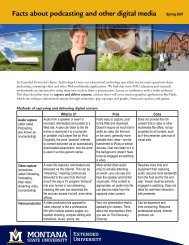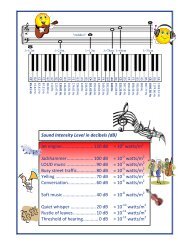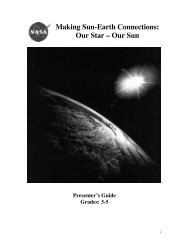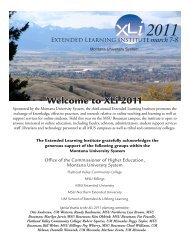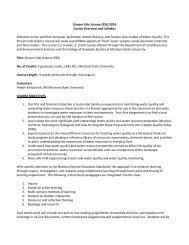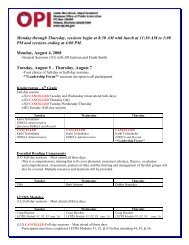Create successful ePaper yourself
Turn your PDF publications into a flip-book with our unique Google optimized e-Paper software.
<strong>Rocket</strong> Activity<br />
<strong>High</strong>-Power<br />
Paper <strong>Rocket</strong>s<br />
Objective<br />
Construct and launch high-power paper<br />
rockets, evaluate their flights, and modify their<br />
design to improve flight performance.<br />
National Science Content Standards<br />
Unifying Concepts and Processes<br />
• Evidence, models, and explanation<br />
• Change, constancy, and measurement<br />
Science as Inquiry<br />
• Abilities necessary to do scientific<br />
inquiry<br />
Physical Science<br />
• Position and motion of objects<br />
• Motions and forces<br />
Science and Technology<br />
• Abilities of technological design<br />
National Mathematics Content Standards<br />
• Number and Operations<br />
• Geometry<br />
• Measurement<br />
• Data Analysis and Probability<br />
National Mathematics Process Standards<br />
• Problem Solving<br />
• Reasoning and Proof<br />
• Communication<br />
• Connections<br />
• Representations<br />
Description<br />
Students construct large paper rockets and<br />
test fly them using the high-power paper<br />
rocket launcher. Following their rocket’s<br />
flight, students rethink their rocket designs,<br />
modify them, and fly them again to determine<br />
if their changes have affected the rocket’s<br />
performance. Students conclude the activity by<br />
writing a post-flight mission report.<br />
Materials<br />
<strong>High</strong>-Power Paper <strong>Rocket</strong> Launcher (see<br />
activity)<br />
Bicycle pump with pressure gauge or<br />
small electric compressor<br />
Paper 8 1/2 X 11” (white or color)<br />
Cellophane tape<br />
Ruler<br />
Protractor<br />
Scissors<br />
1/2” PVC pipe 24” long<br />
Student sheets<br />
Management<br />
Make sure that the rocket body tubes students<br />
roll are slightly loose. They should slide freely<br />
along the construction form tube. If not, it will<br />
be difficult to slide the completed rockets over<br />
the launch rod. Also make sure that students<br />
attach their nose cones securely to the body<br />
tubes.<br />
91
Two sheets of paper are sufficient for<br />
making a rocket. If colored paper is used,<br />
students can trade scraps with each other to<br />
have different colored nose cones and fins.<br />
Background<br />
<strong>High</strong>-power paper rockets are merely a large<br />
version of the paper rockets constructed in<br />
the 3, 2, 1, Puff! activity presented earlier.<br />
The main difference is in how the rockets are<br />
launched. These rockets are propelled by the<br />
air rocket launcher constructed in the previous<br />
activity. A much more powerful blast of air<br />
is achievable than with lung power through<br />
a straw. The launcher is like an air-powered<br />
cannon. However, the rocket surrounds the<br />
launch rod (similar to a cannon barrel). <strong>High</strong>pressure<br />
air fills the rocket. If the rocket were<br />
firmly attached to the rod, the nose cone and<br />
the forward end of the rocket would blow apart.<br />
Instead, the rocket begins sliding along the rod<br />
as it continues to fill with air. Immediately after<br />
clearing the end of the rod, air inside the rocket<br />
expands backward out the lower end. The<br />
action-reaction effect (Newton’s third law) adds<br />
thrust to the already moving rocket.<br />
If the rocket is well-designed and<br />
constructed, flights of more than 100 meters<br />
are possible. The primary determining factor<br />
for performance is drag or friction with the air.<br />
<strong>Rocket</strong>s with very big floppy fins have a great<br />
amount of drag, and flights are usually short.<br />
Very squat nose cones also increase drag. The<br />
idea is to design a rocket that is streamlined so<br />
that it slices cleanly through the air. Through<br />
repeated flights, students discover that small<br />
and very straight fins are preferred along with<br />
long nose cones.<br />
Tip Make sure students launch their rockets<br />
at the same angle and use the same pressure<br />
each time (experiment control).<br />
Procedure Constructing the <strong>Rocket</strong><br />
1. Begin construction by rolling a cylinder of<br />
paper around the 1/2” PVC pipe. The paper<br />
can be rolled the long or short direction to<br />
make a tube 11 1/2” long or 8 1/2” long.<br />
Tape the seam.<br />
2. Demonstrate how the nose cones are<br />
formed. Cut the half circle and curl its<br />
corners to form the cone shape. The round<br />
edge forms the base of the cone. The<br />
straight edge folds in the middle to form the<br />
apex as the sides overlap. Tape the seam.<br />
3. Place the nose cone over the paper body<br />
tube (keep the PVC pipe inside for support).<br />
Fit the cone to the outside dimension of the<br />
body tube. Trim off the excess paper and<br />
tape the cone securely.<br />
4. Cut rocket fins and tape them to the lower<br />
end of the body tube. The rocket is ready for<br />
launch.<br />
5. Have students launch their rockets two or<br />
more times. Before the second launch,<br />
students should do something to modify their<br />
rockets to improve their flight performance.<br />
After their flights, they should record their<br />
observations on the mission report.<br />
Discussion<br />
• How can air rockets be modified to improve<br />
their flight performance<br />
There are several possible adjustments to the<br />
air rocket design. How loose or tight the tube<br />
is in relation to the launch rod affects air flow.<br />
The size and shapes of the fins affect air drag.<br />
Having fins mounted straight on the body of<br />
the rocket also affects drag. The length of the<br />
cone, squat or slender, affects how the rocket<br />
slices through the air.<br />
• Is it OK to change the fins and the nose cone<br />
at the same time<br />
Yes. However, it will not be possible to<br />
attribute improvements in flight performance<br />
to the changes that made a difference. Think<br />
of the design/redesign process as a controlled<br />
experiment where only one variable is<br />
changed at a time.<br />
92
Assessment<br />
• Review student mission reports and their<br />
conclusions.<br />
• Have students write a paper explaining the<br />
principles of rocket flight as they apply to<br />
their paper rockets.<br />
Extensions<br />
• Have students draw one to three imaginative<br />
air rocket designs and speculate on how they<br />
would perform in flight. Have them build one<br />
of their designs and test it.<br />
• Investigate fin placement on air rockets. Have<br />
students construct a new rocket but place<br />
the fins in different locations such as near the<br />
nose cone. Have them test the rockets and<br />
discuss their performance.<br />
• Have students personalize their rockets with<br />
colored markers.<br />
How well will a rocket designed<br />
like this fly<br />
93
Making a Basic <strong>High</strong>-Power Air <strong>Rocket</strong><br />
A<br />
1.<br />
Roll a tube of paper.<br />
Use the pipe for<br />
support.<br />
C<br />
C<br />
2. 3.<br />
Tape the seam<br />
of the tube.<br />
B<br />
Curl a nose cone from a<br />
semicircle. Tape the seam.<br />
B<br />
A<br />
4.<br />
Trim the cone to fit<br />
the tube. Tape it to<br />
the tube.<br />
5.<br />
Tape fins to<br />
the other end<br />
of the tube.<br />
Ready for<br />
LAUNCH!<br />
94
Air <strong>Rocket</strong> Mission Report<br />
Test Flight 1 Summary:<br />
Name: _________________________<br />
Final <strong>Rocket</strong> Design<br />
Body Tube Length: __________ cm<br />
Nose Cone Length:__________ cm<br />
Number of Fins:_____________<br />
Area of 1 Fin: ______________ square cm<br />
How far did the rocket travel ____________________<br />
Describe the flight of the rocket. (Did it fly straight,<br />
wobble, drop quickly to the ground, etc)<br />
Test Flight 2 Summary:<br />
Body Tube Length: __________ cm<br />
Nose Cone Length:__________ cm<br />
Number of Fins:_____________<br />
Area of 1 Fin: ______________ square cm<br />
What did you do to improve the rocket<br />
Predict how far the rocket will fly. _________________<br />
Describe the flight of the rocket.<br />
How far did the rocket travel ____________________<br />
Did your improvements work Why or why not<br />
95
<strong>Rocket</strong> Fin Design<br />
Design your fin on<br />
the first graph.<br />
Estimate its area by<br />
counting the number<br />
of whole squares it<br />
covers. Look at the<br />
squares partially<br />
covered. Estimate<br />
how many whole<br />
squares they are<br />
equal to. Add the<br />
two numbers<br />
together.<br />
Area =<br />
__________<br />
square cm<br />
Redesign your fin.<br />
Area =<br />
__________<br />
square cm<br />
96



